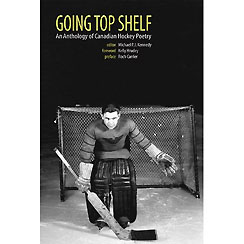| ________________
CM . . .
. Volume XIII Number 5 . . . .October 27, 2006 
 |
Going Top Shelf: An Anthology of Canadian Hockey Poetry.
Michael P. J. Kennedy.
Surrey, BC: Heritage House, 2005.
110 pp., pbk., $15.95.
ISBN 1-894384-99-7.
Subject Headings:
Canadian poetry (English)-20th century.
Hockey-Poetry.
Grades 10 and up / Ages 15 and up.
Review by Dave Jenkinson.
*** /4
|
| |
|

excerpt:
The Hockey Song
Stompin’ Tom Connors
Hello out there we’re on the air it’s hockey night tonight
Tension grows the whistle blows and the puck goes down the ice.
The goalie jumps and the players bump and the fans all go insane
Someone roars “Bobby scores!” at the good ole hockey game.
Chorus:
Oh the good ole hockey game is the best game you can name
And the best game you can name is the good ole hockey game.
Going Top Shelf’s editor, Michael P .J. Kennedy teaches a course entitled “Reading Culture in Canadian Literature” at the University of Saskatchewan and has previously edited Words on Ice: A Collection of Hockey Prose.
The collection’s 47 entries, a mixture of poems and song lyrics, are divided into four sections: “More Than a Game” (10 pieces); “Life Reflected in the Ice” (11); “Home Ice Advantage” (9), and the largest, “Winners and Losers” (17). At the book’s conclusion, an alphabetically arranged “Roster of Authors” provides brief biographical information about the 31 individuals and groups whose “poetic” contributions are found within the book’s four sections. Musical contributors include the groups The Arrogant Worms, The Rheostatics and The Tragically Hip and three individual artists: Kathleen Edwards, Jane Siberry and Stompin’ Tom Connors. In some cases, Kennedy has selected more than a single poem from the work of the 25 poets, and four poets account for a third of the book’s entries: Stephen Scrivner is represented five times, John B. Lee and Richard Harrison four times, and Birx Sproxton three times.
Though some of the poems, such as Stephen Scrivner’s “New Season” or Hugh MacDonald’s “Behind the Red Brick House,” will probably appeal more to adults who are nostalgically looking back at their own playing days, there are many others whose contents will certainly resonate with adolescents. For instance, fans of CBC’s Hockey Night In Canada will enjoy Richard Harrison’s poetic description of Don Cherry, “the priest of rock ‘em sock ‘em” in “Coach’s Corner.” Anyone who has played organized hockey can relate to the painful humour in Scrivner’s “Once is Too Many” in which the poem’s anonymous narrator admits in the first stanza:
I only forgot to wear my can
once that was enough
He then goes to explain that he didn’t come to the realization that he had forgotten to don this essential piece of protective gear until he was on the ice playing his first shift, and then he found himself screening the opposition goalie on a blast from the point. The poems offer other moments of potential recognition. While many young players who play defence may dream of being the next high scoring blue liner like Bobby Orr, the reality is that they may play for a coach like the one found in Birk Sproxton’s “The Song of the Stay-at-Home Defenceman.” And who hasn’t dreamed of playing in a championship game in which the score is tied with just moments left and having the experience of scoring or assisting on the winning goal. Such is the situation in Gary Hyland’s “The B-P-T,” but, as the poem’s narrator discovers, to his continuing shame, the difference between being a hero and a goat can reside in an errant pass.
Though most of the poems are male focused in their content, females in hockey are not entirely overlooked, and Richard Harrison’s “Rhéaume” and Lorna Crozier’s “Canadian Angels” (which an accompanying note explains was “written for our women’s hockey team at the Olympics for the final against the Americans, February 21, 2002”) are just two of the more female-friendly entries.
Hockey fans will recognize the book’s title as a hockey expression indicating that a player has scored by putting the puck up and over the goalie and into the goal’s top portion. In general terms, Kennedy has definitely scored with this collection. However, for adolescent readers, the book’s principal potential downside resides in the small font size that is used for the poetry/lyrics and which, for some unknown reason, is smaller than the font utilized in the introductory “Foreword,” “Preface” and “Introduction.” Unfortunately, the small print, coupled with the book’s inclusion of a number of black and white photos only from the very early years of hockey (including the cover photo), may deter some teen readers from voluntarily picking up the book. Nonetheless, high school English teachers should not only mine this collection for some of its poetic gems, but they should also peruse Kennedy’s closing 10-page “Hockey in Canadian Literature: A Selected Bibliography” for additional potential classroom resources.
Recommended.
Dave Jenkinson teaches courses in children’s and YA literature in the Faculty of Education, the University of Manitoba.

To comment
on this title or this review, send mail to cm@umanitoba.ca.
Copyright © the Manitoba Library Association. Reproduction for personal
use is permitted only if this copyright notice is maintained. Any
other reproduction is prohibited without permission.
NEXT REVIEW |
TABLE OF CONTENTS FOR THIS ISSUE
- October 27, 2006.
AUTHORS |
TITLES |
MEDIA REVIEWS |
PROFILES |
BACK ISSUES |
SEARCH |
CMARCHIVE |
HOME |
